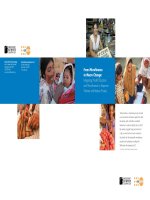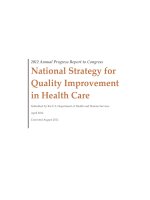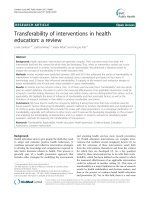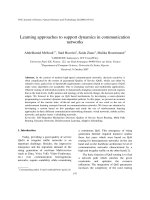Approaches to GIS Programs In Health Education pdf
Bạn đang xem bản rút gọn của tài liệu. Xem và tải ngay bản đầy đủ của tài liệu tại đây (3.2 MB, 16 trang )
Approaches to GIS Programs
In Health Education
Approaches to GIS Programs in Health Education
Health and human services students need geographic informa-
tion system (GIS) technological skills to analyze the geographic
elements of health and human services science. GIS technology
has progressed to a high level of sophistication and, therefore, is
relevant to nearly every emphasis of the health major. The rapid
evolution of GIS as an analytical tool has created specific applica-
tions for multiple health-related fields from environmental and
global health to hospital management and marketing. Its accep-
tance as a strategic component of information technologies and
incorporation into the central systems of many enterprises has
been driven by both analytical capacity and competitive edge.
Although most colleges have GIS in geography or other disci-
plines on campus, few health-related schools offer their under-
graduate and graduate students opportunities for emphasis in
health geography technologies. In the face of industry demand
for qualified health geospatial analysts, some universities are still
debating the validity of GIS in an accredited curriculum while
others are already trying to determine how to position this new
field of study within their programs. A few schools offer health
geographic programs or tracks that include GIS technologies.
Each of these programs is born from unique environments that
influence pedagogical approaches.
This brochure presents five cases that exemplify varied
approaches to GIS academic programs in health-related schools
and three cases where universities are applying geospatial tech-
nology in health research. While these may not represent all of
the ways that GIS can be incorporated into health care programs,
it is meant to highlight some ways that GIS is being used.
©2005 ESRI On-demand reports and maps from Business Analyst Online. Order at www.esri.com/bao or call 800-795-7483 Page 1 of 1
Hospital Map
1 S Memorial Dr Sample
Latitude: 38.624823
Longitude: -90.187827Saint Louis, MO 63102 January 25, 2006
Source: © 2005 Health Forum LLC.
A map prepared using the Business Analyst Online
SM
for Health
application displays hospitals located within a defined area and gives
public health administrators the ability to integrate demographic,
hospital, and other data for planning purposes.
www.esri.com/health
www.esri.com/university
University of Canterbury and Ministry of Health, New Zealand
GeoHealth Laboratory
GIS in Department of Geography
Collaboration with Ministry of Health
Three laboratories and an eight-course progression
The GeoHealth Laboratory is a joint venture between the New
Zealand Ministry of Health Public Health Intelligence (PHI) group
and the Department of Geography’s Health and Environment
research group at the University of Canterbury (UC) in Christ-
church. The collaboration vision is to build a strategic partnership
around health geography, spatial epidemiology, and GIS and to
increase research capacity and outputs in the health and GIS aca-
demic sectors. More than 13,000 undergraduate and 1,900 post-
graduate students are enrolled at the University of Canterbury.
As a result of the driving forces of Paul White, PHI director, and
Dr. Jamie Pearce, UC geography professor and GeoHealth
Laboratory codirector, the laboratory was launched in 2004.
With initial funding provided by the two parent institutions for
three years, the collaboration seeks to advance the university’s
research agenda in the health sciences as well as the strategic
aims of the Ministry of Health. The collaboration provides a
resource that is unique in the Southern Hemisphere.
Staff members work on a range of research projects concerned
with the social and environmental determinants of health and
health care. Projects include neighborhoods and health, health
inequalities, social dimensions of cancer, air pollution and health,
environmental justice, and social gradients in health care utiliza-
tion. In addition, the GeoHealth Laboratory, located in the Depart-
ment of Geography, provides technical and financial resources for
postgraduate students working in geohealth. Each year, the lab
has three or four scholarships available to qualified students.
The university’s Department of Geography established its first
GIS course in the late 1980s thanks to a visionary group of
academics who foresaw the benefits of computer technology
in teaching, research, and administration. GIS course enroll-
ment neared the 200 mark in 2006, and GIS and environmental
remote sensing is one of four specialties that students can follow
toward a geography degree.
The GIS group started out by winning a major university grant
to computerize the Department of Geography building, build
two computer labs, and purchase the requisite hardware and
software. Initially starting with just two ArcInfo
®
licenses running
on UNIX
®
workstations, the GIS program now has 10 ArcInfo
and ArcEditor
™
licenses and unlimited ArcGIS
®
ArcView
®
licenses
running on Windows
®
PCs. Three computer laboratories are
available for teaching undergraduate and postgraduate students
and providing support for researchers in geohealth. ArcGIS
ArcView is also installed in many Department of Geography staff
machines and a growing number of computers in the Biological
Sciences, Civil Engineering, Economics, Forestry, Geology, Math
and Statistics, and Facilities Management departments.
Eight courses follow an integrated teaching pathway and pro-
gression at different levels to accommodate a variety of interests
and experiences. Courses run 12 or 13 weeks. The entry-level
course introduces the fundamental GIS concepts, principles, and
techniques of ArcView; geographic positioning systems; and
remote sensing. Subsequent courses develop skills for acquisi-
tion and analysis of satellite data and its preparation for use in a
GIS. Others introduce theory and methods of spatial analysis and
quantitative GIScience and explore ArcGIS programming and GIS
models. Graduate-level courses examine GIS technical concepts
and applications in research, skills and concepts of environmen-
tal remote sensing, and applications in remote sensing.
Teaching objectives establish
• Fundamental appreciation of spatial analysis theory
• Hands-on software experience including the ESRI
®
ArcGIS Desktop suite
• Appreciation of society-wide impacts of GIScience
• Awareness of spatial data acquisition
Initial program challenges involved selling the concept of new
courses to department heads and gaining access to limited
resources. Once established, the GIS courses became increas-
ingly popular with students from geography as well as other
disciplines. A long-term issue has been the need to provide expe-
rienced teaching and support staff, a situation that is currently
alleviated by providing visiting lecturers and hiring additional
part-time teaching staff.
Air pollutant
concentrations
in Christchurch,
New Zealand
www.esri.com/health
Harvard University, Massachusetts
Harvard School of Public Health
GIS research and teaching in School of Public Health
GIS infrastructure and services in Center for Geographic Analysis
Three main GIS public health research groups
The Harvard School of Public Health (HSPH) was founded in 1922
with the mission of advancing the public’s health through learning,
discovery, and communication. Located in Boston, Massachusetts,
near the Harvard Medical School and several affiliated hospitals,
HSPH pioneered early HIV/AIDS research and has made important
contributions to health findings related to air pollution, nutrition,
coronary heart disease, and diabetes. With an endowment of more
than $800 million, the school employs more than 380 faculty and
640 researchers and occasional instructors; enrollment averages
around 960 students. HSPH degree programs award the master of
science, master of public health, doctor of science, doctor of public
health, and doctor of philosophy.
In addition to supporting computers that are dedicated to research
and located throughout the campus, the HSPH Department of
Information Technology operates the Instructional Computing
Facility to serve the academic computing needs of faculty, fel-
lows, and students. The facility provides 54 student Windows PC
computers, with an additional three classrooms providing between
12 and 20 student computers each. Instructional facility hardware
includes a Sun UNIX file server, Novell file server and PC local area
network, two LaserJet printers, an optical scanner, three slide-
maker machines, and five X terminals.
A site license agreement between Harvard and ESRI provides
students, faculty, and staff with access to the latest GIS software
from ESRI including ArcGIS and many ArcGIS extensions. For
research purposes, students have access to 7.5 GB of GIS files
from ESRI including imagery; the StreetMap
™
USA dataset; and
vector data for the United States, the world, Europe, Canada, and
Mexico. Statistical software applications, such as SAS, Stata, Epi
Info, EpiMap, and S-PLUS, are also available.
The Harvard Center for Geographic Analysis was founded in 2006.
The center, a technology platform in the Institute for Quantitative
Social Science, works across the university to strengthen geographic
information system infrastructure and services. It also builds on
the foundation already created by the Harvard Map Collection and
Harvard Geospatial Library (HGL). HGL holds more than 5,000 layers
of digital geospatial information in vector and raster format along
with Federal Geographic Data Committee (FGDC)-compliant
metadata. HGL now uses the ArcIMS
®
WMS connector to view
open map services and display images managed by ArcSDE
®
.
Some students in public health programs have obtained the most
detailed GIS training to supplement their public health curricu-
lum through courses offered by the Harvard Graduate School of
Design. Other introductory workshops have been sponsored by
the Harvard Map Collection and HSPH. Beginning in spring 2007,
a spatial statistics course will be offered jointly by the HSPH
Biostatistics Department and the Harvard Faculty of Arts and
Sciences Statistics Department.
While individual researchers throughout HSPH use GIS in a wide
range of public health applications, three groups at the school
have been particularly active in promoting the use of GIS and
spatial analysis in public health research: the Exposure, Epide-
miology, and Risk Program (EERP); the Environmental Statistics
group; and the Public Health Disparities Geocoding Project.
EERP operates within the Department of Environmental Health,
where more than 100 interdisciplinary researchers are actively
engaged in studying environmental and occupational hazards.
GIS has been a particularly valuable tool to researchers study-
ing the health effects of air pollution. EERP researchers often
work closely with the Environmental Statistics group within the
Department of Biostatistics.
Environmental health researchers also receive GIS and bio-
statistics support through the Harvard National Institute of
Environmental Health Sciences Center for Environmental Health.
Environmental Statistics group members maintain a Web site
that publicizes current HSPH research that involves GIS in public
health ( />GISinLMA/index.htm).
Researchers in the Department of Society, Human Develop-
ment, and Health at HSPH have created a publication, The Public
Health Disparities Geocoding Project Monograph (www.hsph.
harvard.edu/thegeocodingproject), that provides an introduction
to geocoding and using area-based socioeconomic measures
with public health surveillance data.
Environmental health air pollutants mapping
www.esri.com/university
Columbia University, New York
Mailman School of Public Health
GIS combines public health and urban planning
First course design, instructor material, and real data
Community collaboration projects for hands-on experience
The Mailman School of Public Health (MSPH) of Columbia Univer-
sity in New York City, New York, is one of the first public health
schools in the country and one of the largest. MSPH was the first
institution to establish programs in sociomedical sciences and
psychiatric epidemiology training and to offer a joint degree in
business and public health. It has recently initiated a joint master’s
program in public health and urban planning and is beginning to
incorporate GIS education into its curriculum offerings.
According to Dr. Brandt-Rauf, Columbia professor and chair of
the Department of Environmental Health Sciences, professor of
earth and environmental engineering, and professor of medicine,
“GIS is a very important tool in environment health for visually
mapping and seeing relationships between risk factors. Plotting
data can help with prevention and mitigation efforts.”
The introduction of GIS classes began when Mark Becker and
Meredith Golden, senior research associates at the Center for
International Earth Science Information Network (CIESIN), won
the 2005–2006 Dean’s Award for Excellence in the Curriculum,
providing funds to develop and teach the first class in the spring
of 2006. CIESIN, a unit of the Earth Institute at Columbia, had
already been assisting researchers at the MSPH Columbia Center
for Children’s Environmental Health (CCCEH) and Columbia
Superfund Basic Research Program in integrating spatial analysis
and mapping into their projects. The demand for an introductory
GIS had grown steadily because of these efforts.
Students registered for the GIS class represented a cross sec-
tion of MSPH programs in sociomedical sciences, population
and family health, epidemiology, environmental health sci-
ences, biomedical informatics, general public health for physi-
cians, and Harlem Hospital’s continuing education. The course
was designed to provide basic knowledge in GIS tools and
techniques; population, environmental, and health databases;
geospatial research protocols; and health policy and research
applications. The format was a combination of lectures by
instructors and guest speakers, hands-on lab exercises, class
journal presentations, and a field trip to CIESIN laboratories.
Lectures followed readings from the required text, GIS and Public
Health, by Ellen Cromley and Sara McClafferty. Hands-on GIS
work was drawn from the ESRI Virtual Campus course Learn-
ing ArcGIS 9.1 and from instructor exercises utilizing New York
City (NYC)-specific data and health research planning scenarios.
Guest speakers showed how GIS served as an essential tool
to solve real-world problems in areas such as the GIS center at
the NYC Department of Health and Mental Hygiene, United
Nations Office for the Coordination of Humanitarian Affairs,
and Columbia’s International Research Institute for Climate and
Society. Guest lecturers in many cases encouraged students to
apply for internships.
“GIS is a necessary tool for mapping patterns of health, morbidity,
and mortality,” said Dr. Robert Fullilove, a course guest speaker
and codirector of the MSPH Urbanism and the Built Environment
track. “Pictures are worth a thousand words and can tell a story
more effectively to policy makers than the usual public health
graphs. GIS is where our work is headed.” Urbanism students
are encouraged to take the GIS course as one of their electives.
Students were happy to have the opportunity to get some
hands-on experience with GIS. Graduate student Patricia Peretz
noted that she and her peers are gaining insight into using GIS
for multidisciplinary research that addresses public health issues
from several perspectives. “I have really enjoyed this course,”
said Peretz, “and I hope to utilize GIS in my professional work
once I graduate this spring.”
The course computer lab has 25 machines outfitted with ArcGIS
software and its Spatial Analyst, 3D Analyst
™
, and Geostatistical
Analyst extensions. Under the terms of Columbia’s university site
license program, ArcGIS is also installed in two library computer
labs. Through ESRI’s student trial license program, each class par-
ticipant received a copy of ArcGIS with a number of extensions.
Evaluations from this first offering registered a strong interest
in more advanced GIS and spatial analysis courses. Representa-
tives from the NYC Department of Health and Mental Hygiene
expressed an interest in building closer ties to MSPH through the
development of collaborative GIS projects and training work-
shops. MSPH faculty will be working hard to develop a com-
prehensive geospatial analysis component as an essential and
integrated part of the curriculum.
Visualizing post-9/11 survey data
www.esri.com/health
Loma Linda University School of Public Health, California
Health Geoinformatics Programs
GIS in School of Public Health
GIS integrated into public health education, research, practice
Bachelors and masters programs
Founded in 1905 with a mission of bringing health, healing, and
wholeness to humanity, Loma Linda University (LLU) supports a
health care education program that provides personnel, training,
and logistic support to health services around the world. Located
in Southern California, the university enrolls approximately 3,400
U.S. and international students in health disciplines that include
medicine, nursing, dentistry, pharmacy, allied health, graduate
studies, science and technology, and public health. The LLU
School of Public Health (LLUSPH) was established approximately
40 years ago. Accredited by the Council on Education for Public
Health, LLUSPH operates the university’s health geoinformatics
education programs.
Health geoinformatics is an emerging discipline that uses innova-
tive scientific and geospatial technology to investigate health
issues. Geoinformatics practitioners collect, organize, share, and
present information about where we live, who we are, and how
we live with the ultimate goal of providing optimal solutions to
public health. The LLU health geoinformatics programs prepare
students to apply geospatial information science and technology
to public health learning, research, and practice.
“The LLUSPH vision is to be the premier provider of health geoin-
formatics, training, and education for the public health work-
force in the United States,” said Dr. David Dyjack, LLU interim
dean for the School of Public Health. “The school also supports
efforts to enhance geoinformatics capacity in countries with
developing economies and to advance the use of interoperable
information systems in the many organizations that participate in
public health.”
In 1996, school faculty designed and taught the first graduate-
level GIS course offered at a U.S. school of public health. Two
years later, the university launched the country’s first health
geographics bachelor’s degree. In late 2004, a graduate-level
certificate in health geoinformatics was introduced. Three new
tracks offer GIS degrees in global health and development, busi-
ness administration, and environmental health.
To foster communication with other groups, LLU faculty
members have participated in programs promoting the use of
GIS in public health such as a Centers for Disease Control and
Prevention (CDC)-sponsored satellite broadcast course on health
geoinformatics. In addition, LLU belongs to Earth System Science
Education in the 21st Century, a collaborative program through
which faculty from 20 U.S. colleges and universities share
learning resources.
Loma Linda University students work in the geoinformatics laboratory.
www.esri.com/university
Current study programs include
• Bachelor of science in public health degree program in Health
Geographics and Biomedical Data Management
• Graduate certificate program in Health Geoinformatics
• Master of business administration in GIS track
• Master of public health degree in GIS for Global Health and
Development track
• Master of public health degree in GIS for Environmental
Health track
In the near future, LLU plans to establish a health geoinformatics
education and training resource center. The center will support
the use of spatial technology in health applications in interschool
work, research, and service programs. It plans to develop and
provide GIS educational methods and products that promote sci-
entifically sound public health practices and ethical use, analysis,
and dissemination of data. The center will also develop a con-
tinuing education program in health geoinformatics, establish a
10-week intensive Public Health GIS Institute program, partici-
pate in research promoting the use of geospatial technology,
and support the global use of GIS and spatial analysis in health.
In addition to providing training and education, LLUSPH is
involved in several funded research projects that use geospatial
technology. An Environmental Protection Agency project stud-
ies the cardiovascular health effects of long-term exposure to
ambient air pollutants in California. The African American Health
Initiative project is a community-based participatory planning
project that includes an inventory of all San Bernardino County,
California, health service providers who offer African-Americans
prevention and treatment programs for hypertension, heart dis-
ease, HIV/AIDS, and prostate and breast cancer. LLUSPH is also
one of CDC’s designated Centers for Public Health Preparedness
(CPHP) and a regional academic center of excellence in environ-
mental health with an emphasis on Native American workforce
capacity building.
Program challenges center on funding and include limited
external funding resources and few health GIS internship oppor-
tunities for students. Factors contributing to the success of the
program include an availability of faculty with GIS expertise, sup-
port from program innovators within the School of Public Health,
growing awareness of GIS potential in public health practice,
continued growth of research and integrated use of GIS in
health-related specialties, and support from LLU administration.
Map of standardized mortality rates in California renal transplant patients
www.esri.com/health
University of Mississippi Medical Center, Jackson
GIS Program
Statewide education ESRI software license agreement
GIS and remote sensing
Partnership with NASA to fund geospatial research
The University of Mississippi Medical Center (UMMC) is
the health science campus of the University of Missis-
sippi. In 2000, UMMC was the nation’s first public aca-
demic health center to establish its own GIS program.
Located in Jackson, the state’s capital city, UMMC
houses the Schools of Medicine, Nursing, Dentistry,
Health-Related Professions, and Graduate Studies
in the Health Sciences. It also includes the 722-bed
University Hospitals and Clinics and the Rowland
Medical Library.
“The impetus to begin applying GIS and remote sensing
to health care research at the medical center was the
collective result of a group of people thinking in inno-
vative ways,” said Dr. David Dzielak, UMMC associate
vice chancellor for Strategic Research Alliances. “The
primary element in successfully establishing a program
was receiving really good administrative support from
the institution.”
After the Board of Trustees, State Institutions of Higher
Learning of Mississippi, signed a statewide license agreement
with ESRI, the associate vice chancellor for Health Affairs, School
of Nursing dean, and other administrative leaders supported the
idea of starting an academic program for GIS in health science
applications. The GIS initiative began with a three-fold mission
aligned with the UMMC mission for health professional educa-
tion, patient care, and research.
In 2002, the GIS program acquired its own classroom and built
the lab by using available equipment. Today, the program has
19 new student and research desktop stations with current state-
of-the-art software. GeoMedStat, a software the medical center
developed for GIS-based public health surveillance, is also installed.
The Divisions of Infectious Diseases and Clinical Immunology and
Allergy in the Department of Medicine and the Department of
Pathology, all in the School of Medicine, played critical roles in
the technological advancement of the GIS and remote-sensing
program. These groups fostered a partnership with the National
Aeronautics and Space Administration (NASA) and related
research projects, which helped spark funding and application
ideas. Faculty are currently using GIS to develop applications that
integrate emergency room data, study environmental variables
for infectious diseases, and develop new ways of analyzing can-
cerous cells using hyperspectral images.
Synergistic forces, including staff, faculty, and administration, are
behind the current pace of growth with the objective of being
able to provide leadership in health GIS training and research. A
priority for the program is obtaining external support and col-
laboration through strategic research alliances.
Distribution of Mississippi hospital patients with gastrointestinal syndrome
in 2002, mapped using GeoMedStat, a GIS-based surveillance system
www.esri.com/university
The academic component is available to all medical center gradu-
ate students, and students from any program can take directed-
study courses. Dr. Fazlay Faruque, director of GIS and a professor
of health systems, has more than 15 years of experience in GIS
and remote sensing and is a certified instructor for ArcView and
ArcGIS training courses. Visiting instructors with skills in their
respective areas of specializations teach additional classes.
“The program philosophy is for students to learn GIS as a tool
to enhance the learning process and apply this tool to research
both in health care and in epidemiology,” said Faruque. Courses
have three components: background theory; hands-on training;
and application on a real, but small, project. Most medical center
students are enrolled in the clinical track, and the courses intro-
duce students to the application of GIS in their respective areas.
Major challenges include textbooks, quality health-related data,
and sustained funding. Faruque indicates that textbooks on
health GIS focused on medical and clinical sciences are lacking.
Currently, the ESRI training manual is used for the hands-on
component, and handouts are provided for theory discussions.
“We also owe our success to the really dedicated individuals, such
as Dr. Faruque and his team, who have worked so hard to put
together the program and explain and demonstrate the vision of
this new field,” said Dzielak. “It is very much a cross-disciplinary
project—similar to the way other modern research is moving
forward—with a wide range of expertise within the team.
The program’s five-year goal is to create a top geospatial
research institute for health sciences. Commented Dzielak, “The
future lies in being able to use GIS systems for more complex
analytical challenges, such as for environmental health and map-
ping out disease surveillance in near real time. When you have
an outbreak of symptoms such as a virus and you put them into
a mapping format, the data and the situational awareness jump
right out at you.”
New developments will include courses on GIS and
remote sensing in epidemiology and health care as
well as health GIS training for participants in the
World Health Organization. Research will continue in
the areas of epidemiology and health care.
University of Mississippi Medical Center campus
www.esri.com/health
Duke University, North Carolina
The Children’s Environmental Health Initiative
GIS for research
State, local, and national partnerships
Innovative methodologies and applications
The Children’s Environmental Health Initiative (CEHI) is
a research, education, and outreach program com-
mitted to fostering environments where all children
can prosper. Situated in the Nicholas School of the
Environment and Earth Sciences at Duke University in
Durham, North Carolina, CEHI maintains a staff of 18
full-time research associates and many graduate and
undergraduate research assistants. Marie Lynn Miranda,
Ph.D., serves as the director of CEHI as well as associate
research professor at the Nicholas School. CEHI works
to bridge the social and natural sciences in ways that
provide policy makers and the public with a clearer
sense of the trade-offs in children’s environmental
health program choices. GIS technology plays a promi-
nent role in research design and results presentation.
The long-term vision for CEHI is to use spatial design
of environmental health research to forge a completely
new approach to addressing children’s environmental
health issues. To address children’s health outcomes
fully, CEHI views innovative methods for examining the
simultaneous and combined influences of environmen-
tal, social, and genetic factors as imperative.
Accounting for temporal, spatial, and other unique components
of children’s physical environments, combined with variances in
host and psychosocial factors, can greatly enhance understand-
ing of children’s health. Thus, CEHI’s research mission is to work
collaboratively to develop sound and systematic methodologies
for assessing and analyzing the causal interactions and pathways
through which the environment, host, and psychosocial domains
operate in a child’s life.
Four approaches characterize all CEHI work. First, CEHI focuses
on children, with a special emphasis on the developing fetus
and very young children. Second, CEHI works to provide insight
into how to shift children’s environmental health programs from
mitigation to preventive approaches. Third, CEHI pays particular
attention to issues of environmental justice and health dispari-
ties, striving to identify populations at risk and prioritize them for
preventive intervention and community outreach. Fourth, CEHI’s
technical area of interest is spatial analytics.
At least three things distinguish CEHI’s spatial analytic work from
other research. CEHI has developed methodologies for operating
at very refined levels of geographic resolution that are particu-
larly useful for identifying children at risk for environmental
exposures. CEHI has also developed methods to link previously
unrelated datasets such as census demographic, county tax
assessor parcel, and childhood blood lead screening data. Finally,
from the beginning of the research design of these models and
databases to project end, CEHI strives to incorporate translational
applications including methods for disseminating research results
to the community at the local, regional, and national levels. In
this way, CEHI ensures that public and private health providers,
as well as community groups, are primed to implement policies
based on research findings as soon as they become available.
Display comparing patterns of fungal counts
in homes with specific land type variables
www.esri.com/university
All CEHI team members know how to use ArcGIS software. In
addition, GIS analysts rely on ArcGIS software extensions, such
as ArcGIS Spatial Analyst and Trimble GPS Analyst, to enhance
their work. For fieldwork, CEHI uses Trimble GeoXH
™
GPS
devices. To control data access, all sensitive digital data at CEHI
resides on a completely private (i.e., no access to the Internet),
password-protected network.
Ongoing CEHI research projects range from studying the optimal
spatial design for environmental health research to mapping for
good health and disease prevention. Each project is funded by
one or several outside organizations that include the National
Institute of Environmental Health Sciences, U.S. Department of
Housing and Urban Development, and U.S. Centers for Disease
Control and Prevention.
With funding from CDC, CEHI developed a model of childhood
lead exposure risk spatially resolved at the individual tax parcel
level. The model combines county tax assessor, North Carolina
blood lead screening, and U.S. census data to create a GIS-based
interface for predicting lead exposure risk and communicating
that risk to various audiences. The lead exposure risk model is
a valuable tool to facilitate preventive intervention before lead
poisoning occurs. CEHI is in the process of developing this model
for the entire state of North Carolina as well as in some national
replication sites.
CEHI maintains an expanding network of partnerships and
collaborations with community organizations, researchers, and
regulatory agencies on the local, state, and national levels. By
working through these partnerships to address issues such as
childhood lead poisoning, mercury exposure, indoor air qual-
ity, and the built environment, critical feedback from a variety
of perspectives is channeled into CEHI’s strategies for research
design and implementation.
Map showing spatial pattern of lead exposure risk
priority categories in Durham, North Carolina
www.esri.com/health
Johns Hopkins University, Baltimore, Maryland
Bloomberg School of Public Health
GIS in Department of Molecular Microbiology
Launches student research
Malaria Research Initiative in Africa
Located in Baltimore, Maryland, the Bloomberg School of Public
Health was the first of its kind worldwide and is the largest
school of public health in the world. In addition to educating a
student body of approximately 2,000, school faculty is known
for pioneering new research around the globe.
The school’s Department of Molecular Microbiology and Immu-
nology (MMI) integrates many disciplines concerned with the
study of the transmission of infectious diseases of public health
importance. Research takes place in the laboratory, in the clinic,
and in the field. The department’s Geographic Information
System/Remote Sensing (GIS/RS) Lab was established in 1991 with
the goal of developing and supporting analytical approaches for
identifying environmental risk factors that affect human diseases.
Federal government support of individual investigator projects
provides most of the lab’s funding, although it has also received
substantial support as part of the Malaria Research Initiative, which
is funded by a private donor. The majority of the work in the lab is
done with ESRI and ERDAS
®
products on PC-based computers.
Most students are graduate students or postdoctoral fellows
associated with the School of Public Health. Students receive
training through a two-term set of courses, Spatial Analysis and
GIS, offered through the biostatistics department, and through
special studies courses.
“Many students who have taken the formal coursework have
used their course projects as the starting place for their official
research projects that are later published in the peer-reviewed
literature,” said Gregory Glass, Ph.D., supervisor of the GIS/RS
Lab and MMI professor.
Environmental Surveillance Core Facility for
Malaria Research Initiative
Johns Hopkins Malaria Research Institute
The GIS lab provides support for ecological and environmental
data associated with the school’s initiative for malaria research
in sub-Saharan Africa. To provide spatially explicit environmental
data for researchers, the group relies on current advances in
information technologies, remote sensing, and GIS to generate
and manage the data.
Core personnel use a spatial scale, or GIS mapping, to provide a
common factor for integrating the different environmental cor-
relates of malaria risk. This approach complements and expands
the use of traditional field and laboratory studies. Malaria field
researchers at the school’s Malaria Institute in Macha, Zambia,
link their study data to the core’s environmental GIS data-
base. The data layers are linked to one another in a common
format and scale so researchers can easily query the relation-
ship between measured outcomes, such as the distribution or
abundance of a malaria-carrying mosquito species, and numer-
ous environmental features such as land cover, meteorological
conditions, soil types, and sociological data.
In addition to specific studies, the core maintains a Web-based
service to provide daily updates on the environmental conditions
monitored in sub-Saharan Africa. Data provided by organizations
such as National Aeronautics and Space Administration, National
Oceanic and Atmospheric Administration, and the World Health
Organization is available for climatological modeling of disease
vector (mosquito) population dynamics. Data and maps are avail-
able for land cover type, land surface temperatures, calibrated
radiance, vegetation, air temperature, and precipitation, among
others. For example, satellite sensor estimates of land surface
temperature have been merged with ground station instru-
mentation to obtain approximate +1°C accuracy in recorded
temperature.
Quickbird satellite image
of a site in Zambia used
to study population and
malaria distribution, land
cover patterns, and more,
with ArcGIS
www.esri.com/university
GIS for research
Collaborative use of data from many sources
Designing GIS research tools
The University of California, San Diego (UCSD), is a large research
university with several graduate schools and institutes ranked at the
top of their fields in the nation. The UCSD Department of Neurosci-
ences and the Center for Research on Biological Systems’ (CRBS)
National Center for Microscopy and Imaging Research (NCMIR)
hold top national and international rankings. The San Diego
Supercomputer Center and the California Institute for Telecom-
munications and Information Technology (Calit2) are world leaders
in information technologies supporting large-scale scientific and
engineering projects and home to several of America’s fastest and
most powerful supercomputers, data resources, networking, and
visualization efforts. In the absence of a geography department on
campus, GIS projects have clustered at these research centers.
The Biomedical Informatics Research Network (BIRN), also a CRBS
project, is a collaborative effort in which scientists from these and
other institutions use GIS technology to support biomedical research
and clinical information management. BIRN is harnessing the power
of knowledge sharing to enable new capabilities in large-scale
studies of human disorders. Launched in 2001 as an initiative of
the U.S. National Institutes of Health’s National Center for Research
Resources, BIRN is prototyping the collaborative use of data from
disparate sources to support biomedical research. The coordinating
hub is located at CRBS and oversees the networking, distributed
storage, and software development needs of various “test bed”
neuroimaging projects. More than 30 universities and hospitals and
39 research groups participate in one or more of these projects.
Key BIRN Project Features
• Provide an infrastructure for collaborative medical research
based on a large-scale grid model.
• Develop tools for analysis, visualization, and interpretation of
biomedical data including analysis of spatial relationships.
• Design and deploy tools for the storage, management,
and querying of complex neuroimaging data.
University of California, San Diego
Center for Research on Biological Systems, Calit2, San Diego Supercomputer Center, and the BIRN Project
Using GIS to Map Brain Diseases
Biomedical studies of brain diseases usually center on brain
imagery collected from many different researchers using different
instruments and techniques. Participants in BIRN’s Multi-Scale
Mouse Models of Disease Test Bed use ESRI GIS technology to
permit open access to diverse, distributed data and make compar-
isons using a common mapping system. In other words, they use
GIS technology to spatially integrate distributed multiscale data.
Their efforts resulted in the Spatial Markup and Rendering Tools
(SMaRT) atlas, a spatial database for registration and query-
ing of brain data. BIRN developed the SMaRT atlas using ESRI’s
MapObjects
®
—Java
™
Edition. BIRN uses ArcInfo tools to align
and analyze biological images and brain segmentations retrieved
from partner university servers including ArcIMS servers. Instead
of standard geographic nomenclature, the SMaRT atlas uses the
scientific community’s standard coordinate system for regions
in the brain. One geographic feature layer is the anatomical
delineations of the brain and their associated medical labels.
Researchers can easily query, integrate, and retrieve images or
biological data referenced to the standardized coordinate system.
Diagram of participants in the Biomedical Informatics Research Network
Images of mapped brain cross-sections are made
available through a collaborative spatial database.
www.esri.com/health
Administrative support is key
Funding and teaching approaches vary
Teaching resources are expanding
What can you do to add GIS to the offerings of your health edu-
cation institution? These schools cite the perception by admin-
istration, faculty, and students that GIS is a viable discipline
for health science as a primary element for implementing and
sustaining a successful GIS program. Geographic information
technology is increasingly successful in bringing new applica-
tions to health science, and many faculty researchers include
geospatial components in their health research programs. How-
ever, most colleges are just beginning to implement GIS into the
health curricula. Several models are in place for schools that plan
to incorporate GIS curricula in their health education programs.
Attitudes about the placement of GIS within the academic
institution are still being formulated, but more often than not,
ownership lies outside the health education department. Regard-
less of the department or departments that run the GIS program,
facilitators who actively offer technology accessibility to a wide
scope of disciplines have a broader opportunity for applications
and benefit. Health-related schools lacking GIS resources have
been proactive in seeking them through interdepartmental
cooperation, grant writing, and the development of strategic
research alliances.
Research alliances help establish funding for acquiring technol-
ogy and some student scholarships. The research programs also
provide an opportunity for students to work with real data, learn
sophisticated GIS techniques and modeling, and apply GIS tech-
nology solutions to real health and human services issues.
Pedagogical approaches differ between schools. Some focus
more on developing GIS technological skills; others focus more
on analysis within the body of health science. Both approaches
blend technology and science, but the balance of emphasis
varies, as does the use of class materials and project types. On
one hand, formulaic approaches that use tried and proven data
and projects geared for success allow students to learn a wide
range of applications. On the other hand, real-world projects
and research offer a comprehensive view of how GIS seats itself
within the organization and introduce the student to project
management experience.
Some instructors were frustrated by a lack of health-specific
textual resources for classroom support and research projects.
Faculties enrich course material by bringing in guest speakers
and developing collaborative projects with local health depart-
ments, but there is a need for case studies, shared data for
research projects, and local health community relationships.
Some schools broaden students’ experiences and networks by
hosting workshops and conferences.
Getting Started with GIS in Health Education
ESRI Press offers a new health-specific teaching resource,
GIS Tutorial for Health, by Kristen S. Kurland and Wilpen L. Gorr.
Other relevant ESRI Press publications include GIS for Health
Organizations by Laura Lang; Cartographies of Disease: Maps,
Mapping, and Medicine by Tom Koch; GIS Tutorial: Workbook
for ArcView 9 by Kristen S. Kurland and Wilpen L. Gorr; and
Designing Geodatabases: Case Studies in GIS Data Modeling
by Dr. David K. Arctur and Michael Zeiler.
Success in all the schools in this study was a result of strong
administrative support. Proponents of GIS for health education
face the task of both formulating and changing the positions of
administrators, faculty, and students about the advantages GIS
brings to health sciences. Attitudinal change frequently comes
by creating awareness.
The tactics employed by the schools in this study for improving
teacher education and learning resources include establishing
their own education and training resource centers, sharing learn-
ing resources with other higher education institutions, sponsor-
ing collaborative workshops and satellite broadcast courses, and
developing relationships with the health community and GIS
industry.
Additional resources for learning more about GIS in health and
education and course listings are available at
www.esri.com/health
www.esri.com/university
www.esri.com/industri es/ heal th/resources/training.html
For more information, contact Peggy Harper, ESRI health and
human services industry solutions team, at
GIS Tutorial for Health, an ESRI Press textbook
designed to help students use GIS to solve problems and
gain hands-on experience with health-related data
www.esri.com/university
Canada
McMaster University
School of Geography and Earth Sciences
Hamilton, Ontario, Canada
Course Title: Applications Course
University of British Columbia
Department of Geography
Vancouver, British Columbia, Canada
Course Title: Applied GIS in Conservation Biology, Health Geography,
and Crime Analysis
New Zealand
University of Canterbury
GeoHealth Laboratory
Waitaha, Christchurch, New Zealand
Course Titles: Geography, Health and Welfare and Geospatial
Information Technology for Health Scientists
United Kingdom
University of Bristol
Department of Social Medicine
Bristol, United Kingdom
Course Title: Geographical Information Systems
University of Leeds
School of Geography
Leeds, United Kingdom
Program: Master’s in Geographical Information Systems
University of London
London School of Hygiene and Tropical Medicine
London, United Kingdom
Course Title: Two-Day Introduction to Geographical Information Systems
and the Software ArcView
United States
Carnegie Mellon University
H. John Heinz III School of Public Policy and Management
Pittsburgh, Pennsylvania
Course Title: Health Geographical Information Systems
Columbia Univeristy
Mailman School of Public Health, Environmental Health Sciences
New York City, New York
Course Title: Environmental Health Science GIS
East Tennessee State University
Public Health Department
Johnson City, Tennessee
Web site: www.etsu.edu
Emory University
Rollins School of Public Health, Department of Biostatistics
Atlanta, Georgia
Course Title: Geographic Information Systems for Public Health
Program: Master’s in Public Health Informatics
Florida A&M University
Institute of Public Health
Tallahassee, Florida
Course Title: Demographic Analysis Using GIS
George Mason University
Office of Continuing Professional Education
Fairfax, Virginia
Course Title: Public Health Administration and Analysis
Harvard University
School of Public Health
Boston, Massachusetts
Course Titles: GIS and Health Planning: Facilitating Use of Geographical Data
in Public Health and Spatial Statistics for Health Research
Johns Hopkins University
Bloomberg School of Public Health
Baltimore, Maryland
Course Title: Epidemiologic Applications of GIS
Loma Linda University
School of Public Health
Loma Linda, California
Programs: Bachelor’s in Health Geographics, Health Geoinformatics
Certificate Program, and Health Geoinformatics Summer Institute
New York University
Robert F. Wagner Graduate School for Public Service
New York City, New York
Course Title: GIS in Health Care
State University of New York (SUNY)—Albany
School of Public Health
Albany, New York
Course Title: Geographic Information Systems (GIS) and Public Health
Tulane University
School of Public Health and Tropical Medicine
New Orleans, Louisiana
Course Titles: Introduction to Public Health GIS and Introduction to ArcGIS I
University of California, Berkeley
School of Public Health
Berkeley, California
Course Title: GIS and Remote Sensing in Public Health
University of Illinois, Chicago
School of Public Health
Chicago, Illinois
Course Title: Geographic Information System Application in Public Health
University of Illinois, Urbana-Champaign
College of Veterinary Medicine
Urbana, Illinois
Course Titles: Workshop in GIS and Spatial Analysis for Public Health and
Spatial Epidemiology
University of Mississippi Medical Center
Jackson, Mississippi
Course Titles: Introduction to Geographic Information Systems (GIS) and
Environmental Health
University of North Carolina at Chapel Hill
University Libraries
Chapel Hill, North Carolina
Course Title: GIS and Health Geography
University of Pittsburgh
Department of Behavioral & Community Health Sciences
Pittsburgh, Pennsylvania
Course Title: Information Management in Public and Nonprofit Organizations
Institutions Offering Health-Related GIS Courses
Many higher education institutions offer health-related GIS courses and programs worldwide. The following is a selected, but not
exhaustive, list of courses and programs offered in Canada, New Zealand, the United Kingdom, and the United States.
104844
UBS5M5/ 07dh
Copyright © 2007 ESRI. All rights reserved. ESRI, the ESRI globe logo, ArcGIS, 3D Analyst, StreetMap, ArcIMS, ArcSDE, ArcInfo, ArcEditor, ArcView, ArcMap, Business Analyst Online, MapObjects, @esri.com,
and www.esri.com are trademarks, registered trademarks, or service marks of ESRI in the United States, the European Community, or certain other jurisdictions. Other companies and products mentioned
herein may be trademarks or registered trademarks of their respective trademark owners.
No. GS-35F-5086H
Printed in USA
ESRI International Offices
ESRI Regional Offices
Olympia
360-754-4727
St. Louis
636-949-6620
Minneapolis
651-454-0600
Boston
978-777-4543
Washington, D.C.
703-506-9515
Charlotte
704-541-9810
San Antonio
210-499-1044
Denver
303-449-7779
California
909-793-2853
ext. 1-1906
1-800-GIS-XPRT (1-800-447-9778)
www.esri.com
Locate an ESRI value-added reseller
near you at
www.esri.com/resellers
Outside the United States,
contact your local ESRI distributor.
For the number of your distributor,
call ESRI at 909-793-2853,
ext. 1-1235, or visit our Web site at
www.esri.com/distributors
For More Information
ESRI
380 New York Street
Redlands, California
92373-8100 USA
Phone: 909-793-2853
Fax: 909-793-5953
E-mail:
For more than 35 years, ESRI has
been helping people make better
decisions through management
and analysis of geographic
information. A full-service GIS
company, ESRI offers a framework
for implementing GIS technology
and business logic in any
organization from personal GIS on
the desktop to enterprise-wide GIS
servers (including the Web) and
mobile devices. ESRI GIS solutions
are flexible and can be customized
to meet the needs of our users.
Philadelphia
610-644-3374
Australia
www.esriaustralia.com.au
Belgium/Luxembourg
www.esribelux.com
Bulgaria
www.esribulgaria.com
Canada
www.esricanada.com
Chile
www.esri-chile.com
China (Beijing)
www.esrichina-bj.cn
China (Hong Kong)
www.esrichina-hk.com
Finland
www.esri-finland.com
France
www.esrifrance.fr
Germany/Switzerland
www.esri-germany.de
www.esri-suisse.ch
Hungary
www.esrihu.hu
India
www.esriindia.com
Indonesia
www.esrisa.com.my
Italy
www.esriitalia.it
Japan
www.esrij.com
Korea
www.esrikr.co.kr
Malaysia
www.esrisa.com.my
Netherlands
www.esrinl.com
Northeast Africa
202-516-7485
Poland
www.esripolska.com.pl
Portugal
www.esri-portugal.pt
Romania
www.esriro.ro
Singapore
www.esrisa.com
Spain
www.esri-es.com
Sweden
www.esri-sweden.com
Thailand
www.esrith.com
United Kingdom
www.esriuk.com
Venezuela
www.esriven.com









